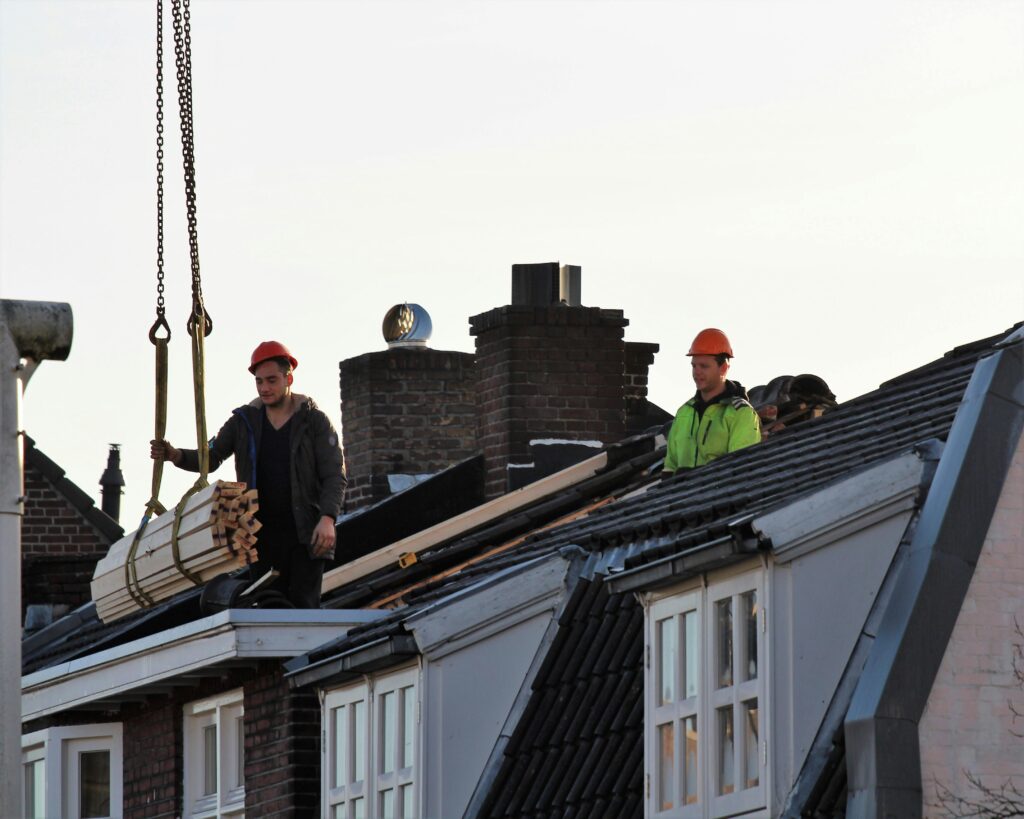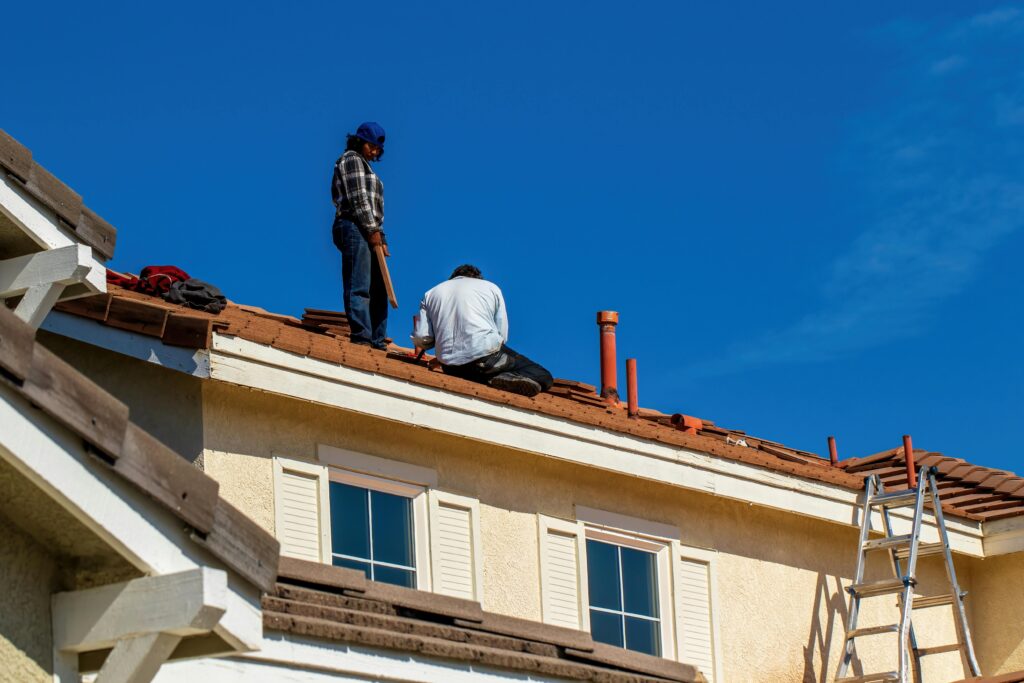Whether you’re contemplating a new build, a renovation, or simply seeking ways to improve your existing roof’s resilience, understanding these emerging trends is key. From innovative materials that repel mildew to smart ventilation designs that encourage airflow, the roofing landscape is evolving to meet the unique challenges posed by humid environments. By the end of this piece, you’ll gain valuable insights into the most effective roofing techniques and products designed specifically for high-moisture areas, empowering you to make informed choices that blend durability with style.
Join us as we uncover how modern technology and design philosophies are shaping the future of trends in roofing for humid climates, ensuring your home remains a fortress against humidity’s persistent threat.
Table of Contents
ToggleKey Takeaways
- Choose Moisture-Resistant Materials: Opt for metal, clay, or advanced synthetics designed to repel water and inhibit mold.
- Optimize Ventilation: Incorporate ridge, soffit, or powered vents to maintain continuous airflow and prevent condensation.
- Use High-Performance Underlayments: Self-adhering bitumen and liquid-applied membranes offer seamless waterproof protection.
- Embrace Sustainable Solutions: Green roofs and reflective coatings reduce heat gain and naturally manage humidity.
- Prioritize Regular Maintenance: Schedule monthly mold inspections, clear drainage systems, and conduct professional checkups every 1–2 years.
- Leverage Smart Design: Tailor roofing systems to local climate challenges—maximize durability, energy efficiency, and long-term performance.
Why Understanding Trends in Roofing for Humid Climates Is More Crucial Than Ever
When it comes to construction and home maintenance, roofing often doesn’t get the spotlight it deserves, especially in regions with challenging weather conditions like humid climates. “Trends in roofing for humid climates” isn’t just a niche topic; it’s a critical area of focus for homeowners, architects, and builders alike who want to ensure durability, energy efficiency, and long-term protection against moisture-related damage.
What Exactly Are ‘Trends in Roofing for Humid Climates’?
Simply put, these trends refer to the latest materials, technologies, and design strategies specifically tailored for roofing systems that must stand up to high levels of humidity, frequent rainfall, and often, the presence of mold and mildew. Humid climates create a unique challenge: excessive moisture can seep into roofs, causing wood rot, corrosion, and energy loss. It’s no coincidence that regions like the southeastern United States, parts of Southeast Asia, and coastal areas exhibit a higher rate of roof failures and maintenance issues if outdated or improper roofing methods are used.
Why Is This Topic More Important Than You Think?
Recent data highlights the costs and consequences of poor roofing choices in humid environments. According to a 2023 report by the National Roofing Contractors Association (NRCA), homes in highly humid regions experience 30% more roof repairs and replacements compared to those in dry climates, with moisture-related damage accounting for almost half of those issues. The financial impact is staggering, roof repairs due to humidity damage alone can run homeowners thousands of dollars every year.
Beyond cost, improper roofing contributes to long-term structural damage and compromises indoor air quality due to mold growth. This has a direct effect on health; the Centers for Disease Control and Prevention (CDC) link mold exposure with increased rates of respiratory illnesses and allergies. Therefore, staying updated with the latest roofing trends that mitigate these risks isn’t optional, it’s essential.
A Real-Life Success Story: Embracing Innovation to Combat Humidity
Consider the recent renovation of a historic home in Miami, Florida, a city notorious for its high humidity and heavy rainfall. The homeowners opted for a hybrid roofing system integrating asphalt shingles coated with reflective, moisture-resistant technology, combined with enhanced ventilation methods. Within a year, they reported a 25% reduction in their cooling costs and zero incidents of roof leaks or mold growth, issues that had plagued the house for decades.
This example demonstrates the power of aligning with current trends in roofing for humid climates. It’s not just about protecting your home; it’s about investing in smarter, sustainable solutions that pay dividends in comfort, energy savings, and peace of mind.
By understanding and implementing the latest trends in roofing for humid climates, you can effectively safeguard your property against the challenges of moisture while embracing innovations that optimize performance and longevity. In the sections that follow, we’ll dive deeper into these trends, exploring the top materials, designs, and technologies transforming the roofing landscape for humid environments today.
How to Apply Trending Roofing Solutions for Humid Climates Step by Step
When it comes to roofing in humid climates, understanding and implementing the latest trends in techumbre para climas húmedos (roofing for humid climates) can make all the difference. Moisture, mold, and structural damage are constant challenges in these environments. By following a clear, step-by-step guide, you can ensure your roofing system is durable, efficient, and stylish, perfectly adapted to withstand humidity. Here’s how to apply the trending roofing techniques for humid climates effectively:
Step 1: Choose the Right Roofing Material
The foundation of any roof’s success in humid areas lies in selecting materials resistant to moisture and mold. Popular trending materials include:
– Metal Roofs: Corrosion-resistant metals like aluminum or zinc alloy prevent rust and last decades.
– Clay or Concrete Tiles: These materials naturally resist moisture penetration and provide excellent ventilation.
– Synthetic Roofing: Advanced synthetic shingles mimic natural materials but offer superior waterproofing.
When selecting, always check the product’s warranty for humidity resistance and look for certifications indicating mold and moisture prevention.
Step 2: Design an Effective Ventilation System
Proper ventilation is crucial to prevent heat and moisture buildup beneath the roofing surface. Trending ventilation solutions include:
– Ridge Vents: Installed along the peak of the roof to allow hot air to escape.
– Soffit Vents: Located under eaves to facilitate the uptake of fresh air into attic spaces.
– Powered Ventilators: Electric fans that actively remove humid air, highly effective in extreme humidity.
The goal is to maintain airflow that keeps the roof structure dry, avoiding condensation buildup that accelerates decay.
Step 3: Apply Advanced Waterproofing Membranes
Modern roofing trends in humid climates emphasize the use of high-performance waterproof membranes. These are usually installed under the visible roofing material and include:
– Self-adhering Bitumen Membranes: Provide an airtight seal and excellent moisture barrier.
– Synthetic Underlayment: Lightweight, durable, and resistant to mold growth.
– Liquid-Applied Membranes: Form seamless, flexible barriers ideal for irregular roof shapes.
Using these membranes significantly reduces the risk of water infiltration, protecting wooden rafters and ceiling interiors.
Step 4: Incorporate Green Roofing Elements
Eco-friendly green roofing systems are gaining popularity, with both aesthetic appeal and humidity control benefits:
– Living Roofs: Coverings of plants that absorb moisture, reduce heat, and improve insulation.
– Reflective Coatings: Paints or tiles with reflective properties that minimize heat absorption, indirectly reducing humidity effects.
Designing a roof that actively combats humidity with natural solutions underscores the latest trend towards sustainable construction.
Step 5: Schedule Regular Maintenance and Inspections
No matter how advanced your roofing system, upkeep is essential in humid climates. Implement these maintenance habits:
– Monthly inspections for mold and moss growth.
– Clearing gutters and downspouts to ensure proper drainage.
– Checking and repairing sealants or caulking around vents and fixtures.
– Professional inspections every 1-2 years, focusing on insulation and ventilation effectiveness.
These routine actions help maintain the longevity and performance of your roof, preventing costly repairs.
Example: Applying These Steps on a Coastal Home
Imagine applying these trends to a coastal home where humidity and salt air pose severe challenges:
1. Use corrosion-resistant metal roofing coated with a reflective finish.
2. Install ridge and soffit vents optimized for sea breeze airflow.
3. Lay a synthetic underlayment combined with liquid-applied membranes for ultimate waterproof protection.
4. Add a vegetated green roof section that improves insulation and absorbs excess moisture.
5. Establish a maintenance routine focusing on salt residue removal and ventilation checks.
This comprehensive approach showcases how understanding “techumbre para climas húmedos” and integrating these steps ensures a durable, efficient roof tailored for humid environments.
By following this detailed, step-by-step process, you not only keep your roof in peak condition but also embrace the latest trends in techumbre para climas húmedos. Remember, the key is balancing functionality with advances in materials and eco-friendly design to combat the unique challenges posed by humidity.

Tips for Navigating Trends in Roofing for Humid Climates:
✅ Choose Breathable Materials: Opt for roofing materials that allow moisture to escape, preventing mold and mildew buildup.
❌ Avoid Porous Surfaces: Stay away from materials that absorb water easily, as they can deteriorate quickly in humid conditions.
💡 Use Reflective Coatings: Apply reflective paint or coatings to reduce heat absorption and improve energy efficiency.
✅ Incorporate Proper Ventilation: Ensure your roof design includes vents or ridge openings to enhance air circulation and reduce condensation.
❌ Don’t Neglect Maintenance: Regularly check for leaks, cracks, and algae growth to maintain roof integrity over time.
💡 Install Gutters with Screens: Prevent debris from clogging gutters and downspouts, ensuring smooth water drainage.
✅ Opt for Mold-Resistant Underlayment: Use specialized underlayment materials resistant to fungal growth to prolong roofing lifespan.
❌ Avoid Flat Roofs Without Drainage: Flat roofs can pool water; make sure your design includes adequate slope and drainage systems.
💡 Consider Green Roof Options: Green roofs can help regulate temperature and absorb excess moisture, benefiting humid environments.
✅ Prioritize Durable Fasteners: Use corrosion-resistant nails and screws to withstand the challenges of humid weather.
These tailored tips will help your roofing stand strong and efficient amidst the unique challenges posed by humid climates.
Key Concepts
Exploring the realm of trends in roofing for humid climates opens a vivid window into the complex interplay between architecture, environment, and materials science. At its core, the concept revolves around how rooftops, one of the most exposed parts of any building, adapt ingeniously to the distinctive challenges posed by humid climates. The key concepts interwoven with this topic afford us a rich understanding of the building science and design philosophies that define future roofing solutions for such environments.
The Essence of Techumbre in Humid Climates
Techumbre, or roofing, is far more than a protective cover; it acts as the first line of defense against environmental elements. In humid climates, where moisture saturates the air and rainfalls can be relentless, roofing must negotiate a delicate balancing act. It must repel water efficiently, prevent moisture ingress, and facilitate evaporation, all while maintaining structural integrity and aesthetics.
Imagine a roof as a skin , much like human skin protects and regulates our body in different weather conditions. In environments rich in humidity, this “skin” must be uniquely permeable and resilient, capable of managing water like a seasoned dancer who anticipates every move. The intricate dance of moisture control embodies the essence of techumbre tailored for wet regions.
Moisture Dynamics and Roof Behavior
Understanding moisture dynamics is pivotal when discussing roofing trends for humid areas. Here, moisture behaves much like an uninvited guest that can stealthily compromise the entire structure if left unchecked. It penetrates through tiny fissures, condenses within wall assemblies, and fosters mold and mildew growth, which are not mere nuisances but serious threats to health and durability.
The physics behind this relates to condensation and vapor diffusion. Warm, moist air migrating towards cooler roof surfaces cools down and releases water droplets, much like dew forming on early morning grass. Technical roofing solutions thus revolve around managing these moisture flows, allowing vapor escape while preventing liquid water intrusion. This interplay is the invisible battleground where many roofing materials and designs prove their worth or fail.
Material Science and Innovation in Roofing
Material selection in techumbre is like choosing armor for a knight heading into battle against humid adversity. Traditional materials such as clay tiles, wood shingles, or asphalt have proven virtues but also distinct vulnerabilities when confronted by persistent dampness.
Recent trends highlight the rise of advanced materials engineered for enhanced moisture resistance, breathability, and longevity. These include fiber-cement composites, reflective membranes, and treated metal sheets. Such materials don’t just resist water; they actively interact with environmental conditions, using technologies like hydrophobic coatings to repel moisture or micro-venting structures to channel airflow under roofing layers. These innovations transform a humble roof into a dynamic system , a breathing entity attuned to its ecosystem.
Roofing Designs Inspired by Nature and Climate
Beyond materials lie the architectural shapes and designs that have evolved or been reimagined specifically for humid climates. One might picture a roof not as a flat barrier but as a sculptural form shaped by environmental logic.
Steep slopes and expansive overhangs mimic natural formations like leaves or shells, directing water away rapidly and preventing pooling, similar to how water beads and slides off lotus leaves. Ventilation features, such as ridge vents or raised seams, act like the gills or pores of organisms, allowing air to circulate and prevent moisture buildup.
This bio-inspiration seeks harmony with the local climate rather than confrontation, embodying a design philosophy where form follows environmental function. It’s a vivid reminder that roofing trends are as much about respecting nature’s rhythms as about technological prowess.
Sustainability and Longevity: The Twin Pillars
A crucial concept underpinning modern roofing for humid climates is sustainability. The environment that challenges the roof also demands that our solutions minimize ecological impact. Sustainable materials, energy efficiency, and durability are interlaced concepts here.
A roof that degrades quickly under humidity is like a ship constantly needing repairs in stormy seas, a costly, resource-draining endeavor. Conversely, a roof designed with sustainability in mind performs like a seasoned vessel, weathering storms with minimal damage and reducing energy consumption by insulating interiors effectively.
Trends in techumbre integrate these ideals, weaving together thermal insulation techniques, water harvesting capabilities, and recyclable materials, thereby promoting roofs that serve not only the building’s needs but also respect the planet’s finite resources.
In sum, the trends in roofing for humid climates represent an intricate symphony of environmental science, material innovation, and architectural artistry. By viewing roofs through these key lenses, moisture dynamics, material advancement, bioclimatic design, and sustainability, we appreciate how they transform from mere structural elements into sophisticated systems finely tuned to the demands of humid vicinities. It’s a story of resilience, adaptation, and harmony, where technology and nature coalesce on the rooftop stage.
Frequently Asked Questions (FAQs) about Trends in Roofing for Humid Climates
❓ What are the most popular roofing materials for humid climates?
In humid climates, materials like metal, clay tiles, and asphalt shingles with strong algae and moisture resistance are highly favored. These materials effectively prevent mold and mildew buildup, ensuring durability and low maintenance.
❓ How do roofing designs adapt to high humidity environments?
Roofs in humid regions often feature steep pitches and enhanced ventilation systems to facilitate efficient water runoff and air circulation. This reduces moisture retention, minimizing the risk of leaks and structural damage.
❓ Are green roofs or cool roofs effective in humid climates?
Yes, green roofs help absorb rainwater and moderate indoor temperatures, while cool roofs reflect sunlight to reduce heat absorption. Both options contribute to energy savings and increased comfort in humid areas.
❓ How often should roofs be inspected in humid climates?
Due to constant moisture exposure, roofs in humid regions should be inspected at least twice a year. Regular checks help identify early signs of damage like mold growth, corrosion, or shingle deterioration.
❓ Can traditional roofing materials withstand humid weather conditions?
Traditional materials may require special treatments or protective coatings to perform well in humid climates. Without these precautions, they can deteriorate quickly due to prolonged exposure to moisture and biological growth.
By staying informed about the latest trends in roofing for humid climates, homeowners can make smarter choices that combine durability, aesthetics, and environmental efficiency.



One Response